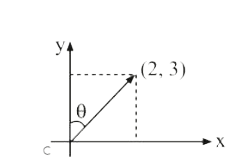Given vector→A=2ˆI+3ˆj , the angle between →A and y-axis is :
tan−13/2
tan−12/32
sin−12/3
cos−12/3
The correct Answer is:b
tanθ=23
θ=−tan−123

Topper's Solved these Questions
- BOOK - VMC MODULES ENGLISHCHAPTER - INTRODUCTION TO VECTORS & FORCES EXERCISE - level 265videos
INTRODUCTION TO VECTORS & FORCES
- BOOK - VMC MODULES ENGLISHCHAPTER - INTRODUCTION TO VECTORS & FORCES EXERCISE - JEE Main ( ARCHIVE ) ( LEVEL-1)12videos
INTRODUCTION TO VECTORS & FORCES
- BOOK - VMC MODULES ENGLISHCHAPTER - INTRODUCTION TO VECTORS & FORCES EXERCISE - JEE Advanced ( ARCHIVE LEVEL-2)12videos
INTRODUCTION TO VECTORS & FORCES
- BOOK - VMC MODULES ENGLISHCHAPTER - GRAVITATIONEXERCISE - JEE Advance (Archive) TRUE/FALSE1videos
GRAVITATION
- BOOK - VMC MODULES ENGLISHCHAPTER - JEE MAIN - 5EXERCISE - PART I : PHYSICS (SECTION - 2)5videos
JEE MAIN - 5
Similar Questions
Dot product of two vectors →A and →B is defined as →A.→B=aBcosϕ , where ϕ is angle between them when they are drawn with tails coinciding. For any two vectors . This means →A.→B=→B.→A that . The scalar product obeys the commutative law of multiplication, the order of the two vectors does not matter. The vector product of two vectors →A and →B also called the cross product, is denoted by →A×→B . As the name suggests, the vector product is itself a vector. →C=→A×→B then C=ABsinθ ,
→A=ˆi+ˆj−ˆk and →B=2ˆi+3ˆj+5ˆk angle between →A and →B isView SolutionIf →A+→B+→C =0 and A = B + C, the angle between →A and →B is :
View SolutionThe area of parallelogram represented by the vectors →A=2ˆi+3ˆj and →B=ˆi+4ˆj is
View SolutionThe maqunitudes of vecotr →A,→B and →C are respectively 12,5 and 13 units and →A+→B=→C then the angle between →A and →B is :
View SolutionWhat is the projection of vector →A=4ˆI+3ˆj on vector →B=3ˆI+4ˆj ?
View SolutionFind unit vectors along →A=ˆI+ˆj−2ˆk and →B=ˆI+2ˆj−ˆk
View SolutionIf ∣∣→A+→B∣∣=∣∣→A−→B∣∣ what is the angle between →A and →B ?
View SolutionIf ∣∣→A−→B∣∣=∣∣→A∣∣−∣∣→B∣∣ the angle between →A and →B is
View SolutionIf →A=→B+→C and the magnitude of →A,→B and →C are 5,4 and 3 units respectively the angle between →A and →C is
View SolutionLet →a=a1ˆi+a2ˆj+a3ˆk,→b=b1ˆi+b2ˆj+b3ˆk and →c=c1ˆi+c2ˆj+c3ˆk be three non- zero vectors such that →c is a unit vectors perpendicular to both the vectors →a and →b. If the angle between →a and →b is π6 then
∣∣ ∣∣a1a2a3b1b2b3c1c2c3∣∣ ∣∣2 is equal toView Solution

